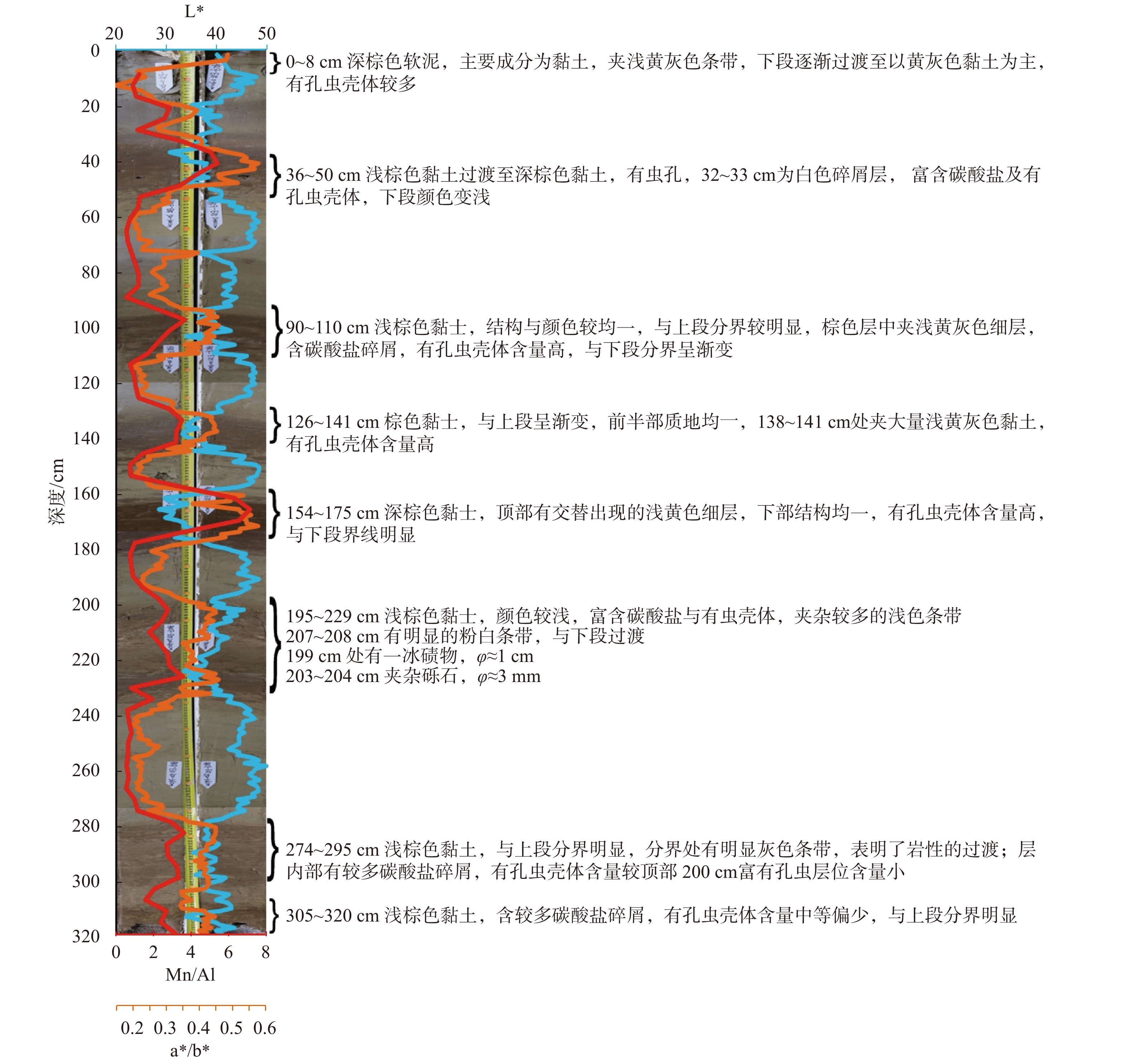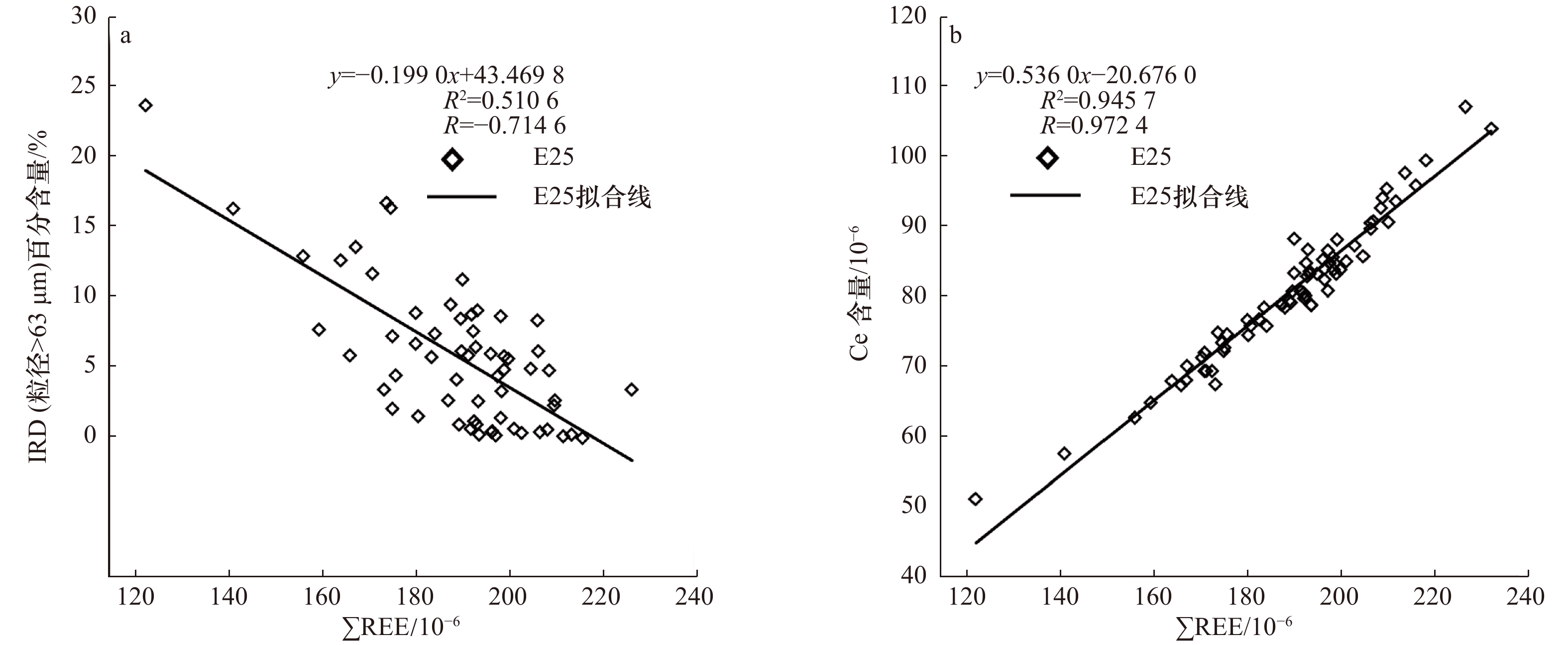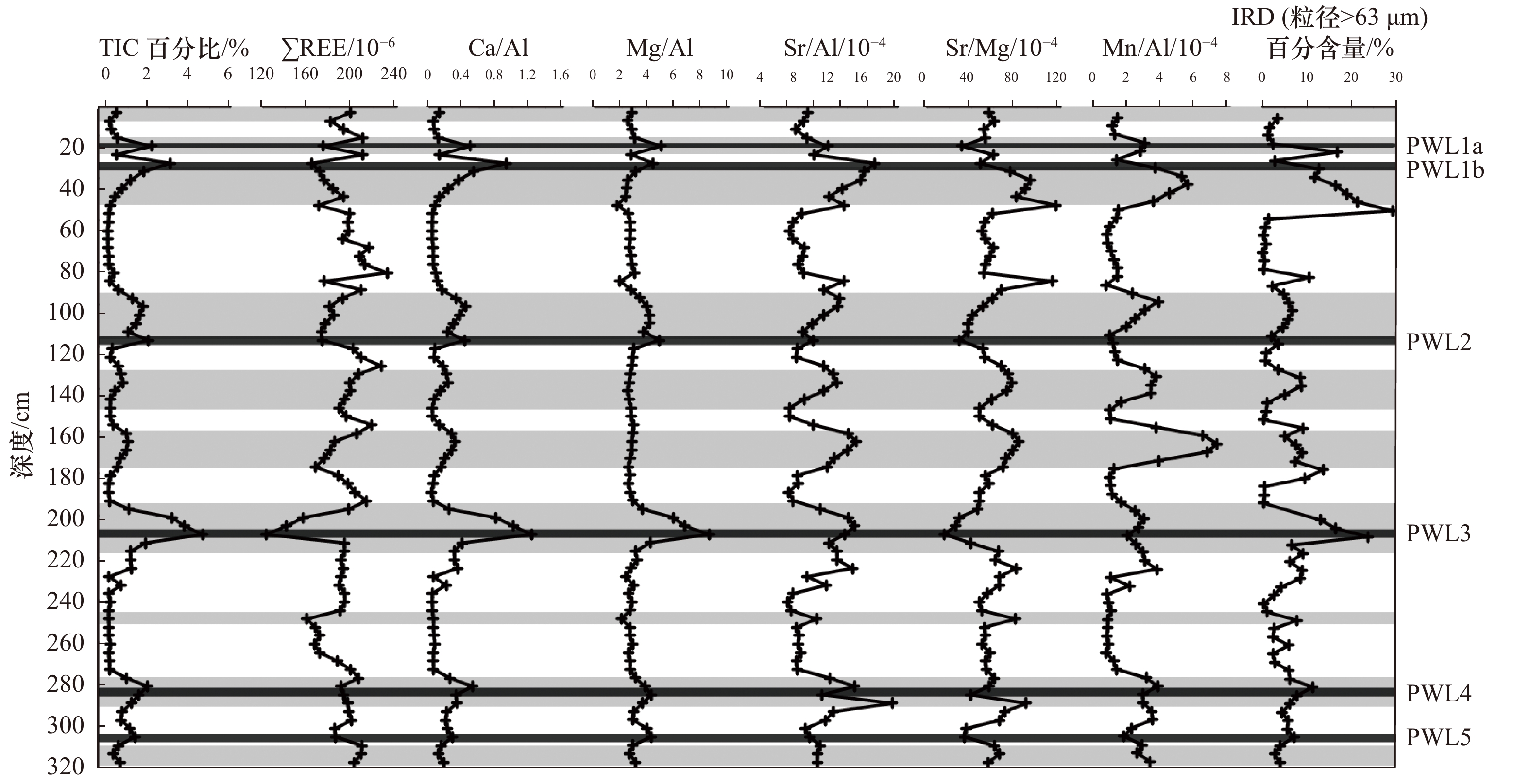Composition and provenance analysis of rare-earth elements in the manganese-rich brown layers of the Mendeleev Ridge, Arctic Ocean
-
摘要: 北冰洋深海广泛分布的富锰棕色沉积层(棕色层)是海冰、洋流、物源供给等多种因素共同作用的结果,本文基于西北冰洋门捷列夫海岭ARC07-E25岩芯沉积物稀土元素与微量元素含量、颜色反射率参数、粗颗粒组分和无机碳含量的变化特征,对该类沉积层中稀土元素的组成特征、形成机制和物质来源进行了综合分析。结果显示,沉积物稀土元素总含量(∑REE)在122.37×10−6~231.94×10−6之间变化,北美页岩标准化配分模式显示出轻微的中稀土(MREE)富集以及由La、Ce、Nd主导的较强的轻稀土(LREE)优势。沉积物中∑REE随着粗组分颗粒(如冰筏碎屑)的增多而呈现降低趋势,表明门捷列夫海脊沉积物中的稀土元素主要富集在细粒沉积物中。根据∑REE在沉积物中的变化特征将E25岩芯沉积物划分为4种地层,反映出了冰期/间冰期的气候转变过程中温暖条件下形成的棕色层与寒冷条件下形成的浅灰绿色沉积层(灰色层)的岩性旋回中稀土元素组成的差异,由于两种沉积层在形成时受到不同的底层水氧化还原环境的控制,导致了铈(Ce)元素在氧化水体中会由Ce3+氧化为Ce4+并发生沉降,而在还原水体中则由Ce4+还原为Ce3+发生溶解,这一特性使LREE含量产生较大波动,进而影响到∑REE,使之趋于在代表氧化条件的棕色层中升高而在代表还原条件的灰色层中降低。R型因子分析和物质来源判别结果显示,E25岩芯沉积物中稀土元素与亲碎屑元素(Nb、U、Th)有较好的相关性,主要来源于东西伯利亚海和新西伯利亚群岛的近岸侵蚀物质以及勒拿河物质的输入。Abstract: The Mn (manganese)-rich brown layers (brown layers) distribute widely in the Arctic Ocean seafloor which controlled by sea ice, surface currents, material supply and so on. In this study, we investigate the provenance and composition feature of brown layers based on changes of contents on rare earth and trace elements, coarse fraction, inorganic carbon and colour reflectance of core ARC07-E25 retrieved from the Mendeleev Ridge, western Arctic Ocean. Total rare earth elements (∑REE) changes between 122.37×10−6 to 231.94×10−6, the north American Shale normalized records of the sediments generally show enrichment in medium rare earth element (MREE) and light rare earth element (LREE) which dominated by lanthanum (La), cerium (Ce) and neodymium (Nd), respectively. With the increase of coarse fraction, such as ice rafted detritus (IRD), the decrease trend of ∑REE indicates REE mainly enrich in fine grain fraction in the Mendeleev Ridge sediments. The differences of REE contents between brown and gray layers, which are classified in the core based on various characteristics of ∑REE, demonstrate distinct Ce anomalies in the brown layer and grey layer associated with different redox conditions: it will be oxidized from Ce3+ to Ce4+ in oxic brown layers and be reduced from Ce4+ to Ce3+ in gray layers. This behavior favors the large variation of ∑LREE content and affects the ∑REE content in the sediments. Consequently, the ∑REE contents are increasing in the brown layers representing oxidation condition and decreasing in the gray layer representing reduction condition. The results of R-type factor analysis show that the REE in sediments have a good correlation with the detritus elements (Nb, U and Th), and mainly derived from inshore erosion of the East Siberian continental shelf, New Siberian Islands and input of the Lena River.
-
图 1 北冰洋海底及周边大陆地形地貌
图中红色六角星代表本文研究站位;浅色半透明区域为北冰洋周边晚更新世主要冰盖的推测位范围[9-10];红色箭头为洋流移动方向;图中涉及到的洋流如下,TPD:穿极流;BG:波弗特环流。底图根据IBCAO Data团队水深模型进行重绘(https://ngdc.noaa.gov/mgg/bathymetry/arctic/arctic.html)
Fig. 1 Topographical and geomorphic of the Arctic Ocean seafloor and surrounding continents
The red hexagonal star represents the research station of this paper. Light-colored semi-transparent area is the potential range of the main ice sheets around the Arctic Ocean in the late Pleistocene[9-10]. The red arrow shows the direction of surface current movement. The ocean currents involved in the figure are as follows: TPD: Trans Polar Drift; BG: Beaufort Gyre. According to IBCAO reproduction Data team depth model redraw (https://ngdc.noaa.gov/mgg/bathymetry/arctic/arctic.html)
图 4 稀土元素相关要素、部分氧化还原敏感元素以及IRD含量对比
深色区域为识别出的棕色层,白色区域为灰色层,NASC为北美页岩标准化
Fig. 4 Comparison of rare-earth elements, some redox sensitive elements and IRD content
The dark areas are the identified brown layers, light areas indicate gray layers, and the NASC is normalization by North American Shale Composite
图 6 经北美页岩标准化后的勒拿河、雅拿河、麦肯锡河河口悬浮体[46-47]和拉普捷夫海、东西伯利亚海表层沉积物[29]稀土元素配分模式图(a);E25站位代表性棕色层与灰色层的北美页岩标准化稀土元素配分模式图(b)
带深度橙色线为棕色层各层位稀土元素配分模式曲线;带深度浅蓝色线为灰色层各层位稀土元素配分模式曲线
Fig. 6 Rare-earth distribution pattern of suspension matters in the estuaries of the Lena, Yana and Mackenzie rivers[46-47] and surface sediments in the Laptev Sea and East Siberian Sea[29] (a), and pattern of rare earth elements in representative brown and gray layers of Core E25, each data has normalized by NASC (b)
Orange lines with depth indicate curves of rare earth elements in brown layesr; blue lines with depth indicate curves of rare earth elements in gray layer
图 7 对E25岩芯沉积物中主要化学元素组成的R型因子分析
I.与氧化还原环境相关的元素;II.与陆源碎屑输入相关的元素;III.与细组分及再搬运有关的元素;IV.与粗组分及重矿物相关的元素;粗组分大于63 μm,细组分小于63 μm
Fig. 7 R-type factor analysis of major elements in Core E25 sediments
I. Elements related to the redox environment; II. elements related to terrigenous detritus input; III. elements related to fine size composition and resuspension; IV. elements related to coarse grains and heavy minerals; coarse component >63 μm, fine component <63 μm
表 1 北冰洋部分海域和主要河流沉积物中平均稀土元素含量(10−6)
Tab. 1 Average rare earth element content (10−6) in sediments of some sea areas and major rivers in the Arctic Ocean
元素 勒拿河(SPM)[45] 拉普捷夫海(SS)[29] 东西伯利亚海(SS)[30] 麦肯锡河(SPM)[32, 46] E25(ACC) 西部 东部 La 43.20 45.50 37.30 24.40 32.10 37.74 Ce 94.80 90.10 76.60 52.20 62.08 81.09 Pr 10.08 9.95 8.18 6.05 7.46 8.95 Nd 36.90 36.60 30.20 23.30 28.47 33.83 Sm 6.58 6.29 5.94 4.80 5.51 6.39 Eu 1.49 1.42 1.19 1.00 1.14 1.48 Gd 6.21 5.64 4.94 4.25 4.86 5.70 Tb 0.81 0.83 0.76 0.61 0.75 0.94 Dy 4.50 4.39 4.08 3.35 4.62 5.57 Ho 0.85 0.83 0.79 0.67 0.95 1.06 Er 2.54 2.48 2.13 1.86 2.71 3.10 Tm 0.32 0.34 0.33 0.27 N.D. 0.49 Yb 2.47 2.35 2.23 1.75 2.60 3.09 Lu 0.32 0.34 0.32 0.25 0.41 0.49 ∑REE 211.07 207.06 174.99 124.76 153.65 189.92 注:SS表示表层沉积物;ACC表示平均含量;SPM表示悬浮体;N.D.表示无数据。 表 2 旋转后的变量载荷矩阵及各因子方差
Tab. 2 Rotated factor matrix and variance contribution of each factor
变量 因子1 因子2 因子3 因子4 方差/% 28.79 22.33 18.97 16.71 Mg/Al 0.959 0.143 –0.089 0.153 Mn/Al 0.958 0.145 –0.091 0.155 Mo/Al 0.941 0.094 –0.131 0.193 Ni/Al 0.870 0.397 0.102 0.046 Co/Al 0.798 0.486 0.119 0.094 Cd/Al 0.796 0.293 0.001 0.387 Sr/Al 0.658 0.177 –0.294 0.547 Nb/Al 0.194 0.872 –0.279 –0.068 Ce/Al 0.364 0.846 0.097 0.112 REE/Al 0.432 0.817 0.031 0.268 Th/Al 0.091 0.812 0.408 0.222 U/Al 0.341 0.685 –0.016 0.514 Ti/Al 0.190 0.621 –0.581 –0.161 Sc/Al 0.099 0.015 0.860 –0.178 Rb/Al –0.359 0.054 0.840 –0.008 Li/Al 0.081 0.229 0.776 –0.162 Zr/Al 0.012 0.383 –0.694 0.489 Hf/Al 0.010 0.475 –0.594 0.520 Ca/Al 0.303 0.204 0.153 0.818 粗组分(粒径>63 μm) 0.230 0.020 –0.413 0.806 细组分(<63 μm) –0.230 –0.020 0.413 –0.806 注:较为显著载荷用(大于0.3)加粗数值进行标识。 -
[1] Vonk J E, Sánchez-García L, van Dongen B E, et al. Activation of old carbon by erosion of coastal and subsea permafrost in Arctic Siberia[J]. Nature, 2012, 489(7414): 137−140. doi: 10.1038/nature11392 [2] Shakhova N, Semiletov I, Sergienko V, et al. The East Siberian Arctic Shelf: towards further assessment of permafrost-related methane fluxes and role of sea ice[J]. Philosophical Transactions of the Royal Society A: Mathematical, Physical and Engineering Sciences, 2015, 373(2052): 20140451. doi: 10.1098/rsta.2014.0451 [3] Tesi T, Muschitiello F, Smittenberg R H, et al. Massive remobilization of permafrost carbon during post-glacial warming[J]. Nature Communications, 2016, 7: 13653. doi: 10.1038/ncomms13653 [4] McLennan S M. Rare earth elements in sedimentary rocks: influence of provenance and sedimentary processes[J]. Reviews in Mineralogy and Geochemistry, 1989, 21(1): 169−200. [5] Phillips R L, Grantz A. Regional variations in provenance and abundance of ice-rafted clasts in Arctic Ocean sediments: implications for the configuration of late Quaternary oceanic and atmospheric circulation in the Arctic[J]. Marine Geology, 2001, 172(1/2): 91−115. [6] Bischof J F, Darby D A. Mid- to late pleistocene ice drift in the western arctic ocean: evidence for a different circulation in the past[J]. Science, 1997, 277(5322): 74−78. doi: 10.1126/science.277.5322.74 [7] Stein R, Matthießen J, Niessen F, et al. Towards a better (litho-) stratigraphy and reconstruction of Quaternary paleoenvironment in the Amerasian Basin (Arctic Ocean)[J]. Polarforschung, 2010, 79(2): 97−121. [8] Stein R. Arctic Ocean Sediments: Processes, Proxies, and Paleoenvironment[M]. United Kingdom: Elsevier, 2008: 3−30. [9] Weber J R. Physiography and Bathymetry of the Arctic Ocean seafloor[M]//Herman Y, eds. The Arctic Seas. Boston, MA: Springer, 1989: 797-805. [10] Niessen F, Hong J K, Hegewald A, et al. Repeated pleistocene glaciation of the East Siberian continental margin[J]. Nature Geoscience, 2013, 6(10): 842−846. doi: 10.1038/ngeo1904 [11] Brigham-Grette J. A fresh look at Arctic ice sheets[J]. Nature Geoscience, 2013, 6(10): 807−808. doi: 10.1038/ngeo1960 [12] Jakobsson M, Nilsson J, Anderson L, et al. Evidence for an ice shelf covering the central Arctic Ocean during the penultimate glaciation[J]. Nature Communications, 2016, 7: 10365. doi: 10.1038/ncomms10365 [13] Svendsen J I, Alexanderson H, Astakhov V I, et al. Late Quaternary ice sheet history of northern Eurasia[J]. Quaternary Science Reviews, 2004, 23(11/13): 1229−1271. [14] Stärz M, Gong Xun, Stein R, et al. Glacial shortcut of Arctic sea-ice transport[J]. Earth and Planetary Science Letters, 2012, 357-358: 257−267. doi: 10.1016/j.jpgl.2012.09.033 [15] Moritz R E. Dynamics of recent climate change in the Arctic[J]. Science, 2002, 297(5586): 1497−1502. doi: 10.1126/science.1076522 [16] Boström K. Origin of manganese-rich layers in Arctic sediments[J]. AAPG Bulletin, 1970, 54(12): 2471−2472. [17] Löwemark L, März C, O’Regan, et al. Arctic Ocean Mn-stratigraphy: genesis, synthesis and inter-basin correlation[J]. Quaternary Science Reviews, 2014, 92: 97−111. doi: 10.1016/j.quascirev.2013.11.018 [18] Darby D A, Naidu A S, Mowatt T C, et al. Sediment composition and sedimentary processes in the Arctic Ocean[M]// Herman Y, eds. The Arctic Seas. Boston, MA: Springer, 1989, 657−690. [19] Poore R Z, Phillips R L, Rieck H J. Paleoclimate record for northwind ridge, western Arctic Ocean[J]. Paleoceanography and Paleoclimatology, 1993, 8(2): 149−159. [20] Darby D A, Polyak L, Bauch H A. Past glacial and interglacial conditions in the Arctic Ocean and marginal seas-A review[J]. Progress in Oceanography, 2006, 71(2/4): 129−144. [21] Rohling E J, Foster G L, Grant K M, et al. Sea-level and deep-sea-temperature variability over the past 5.3 million years[J]. Nature, 2014, 508(7497): 477−482. doi: 10.1038/nature13230 [22] Wang Rujian, Polyak L, Xiao Wenshen, et al. Late-Middle Quaternary lithostratigraphy and sedimentation patterns on the Alpha Ridge, central Arctic Ocean: Implications for Arctic climate variability on orbital time scales[J]. Quaternary Science Reviews, 2018, 181: 93−108. doi: 10.1016/j.quascirev.2017.12.006 [23] Ye Liming, März C, Polyak L, et al. Dynamics of manganese and cerium enrichments in Arctic Ocean sediments: a case study from the alpha ridge[J]. Frontiers in Earth Science, 2019, 6: 236. doi: 10.3389/feart.2018.00236 [24] Jakobsson M, Løvlie R, Al-Hanbali H, et al. Manganese and color cycles in Arctic Ocean sediments constrain Pleistocene chronology[J]. Geology, 2000, 28(1): 23−26. doi: 10.1130/0091-7613(2000)28<23:MACCIA>2.0.CO;2 [25] Polyak L, Curry W B, Darby D A, et al. Contrasting glacial/interglacial regimes in the western Arctic Ocean as exemplified by a sedimentary record from the Mendeleev Ridge[J]. Palaeogeography, Palaeoclimatology, Palaeoecology, 2004, 203(1/2): 73−93. [26] März C, Schnetger B, Brumsack H J. Paleoenvironmental implications of Cenozoic sediments from the central Arctic Ocean (IODP Expedition 302) using inorganic geochemistry[J]. Paleoceanography and Paleoclimatology, 2010, 25(3): PA3206. [27] März C, Stratmann A, Matthies R, et al. Manganese-rich brown layers in Arctic Ocean sediments: composition, formation mechanisms, and diagenetic overprint[J]. Geochimica et Cosmochimica Acta, 2011, 75(23): 7668−7687. doi: 10.1016/j.gca.2011.09.046 [28] O'Regan M, Moran K, Backman J, et al. Mid-Cenozoic tectonic and paleoenvironmental setting of the central Arctic Ocean[J]. Paleoceanography and Paleoclimatology, 2008, 23(1): PA1S20. [29] Astakhov A S, Semiletov I P, Sattarova V V, et al. Rare earth elements in the bottom sediments of the East Arctic seas of Russia as indicators of terrigenous input[J]. Doklady Earth Sciences, 2018, 482(2): 1324−1327. doi: 10.1134/S1028334X18100021 [30] Astakhov A S, Sattarova V V, Shi Xuefa, et al. Distribution and sources of rare earth elements in sediments of the Chukchi and East Siberian Seas[J]. Polar Science, 2019, 20: 148−159. doi: 10.1016/j.polar.2019.05.005 [31] Wang Rujian, Xiao Wenshen, März C, et al. Late Quaternary paleoenvironmental changes revealed by multi-proxy records from the Chukchi Abyssal Plain, western Arctic Ocean[J]. Global and Planetary Change, 2013, 108: 100−118. doi: 10.1016/j.gloplacha.2013.05.017 [32] Fagel N, Not C, Gueibe J, et al. Late Quaternary evolution of sediment provenances in the Central Arctic Ocean: mineral assemblage, trace element composition and Nd and Pb isotope fingerprints of detrital fraction from the Northern Mendeleev Ridge[J]. Quaternary Science Reviews, 2014, 92: 140−154. doi: 10.1016/j.quascirev.2013.12.011 [33] Dong Lisen, Liu Yanguang, Shi Xuefa, et al. Sedimentary record from the Canada Basin, Arctic Ocean: implications for late to middle Pleistocene glacial history[J]. Climate of the Past, 2017, 13(5): 511−531. doi: 10.5194/cp-13-511-2017 [34] Stein R, Fahl K, Schade I, et al. Holocene variability in sea ice cover, primary production, and Pacific-Water inflow and climate change in the Chukchi and East Siberian Seas (Arctic Ocean)[J]. Journal of Quaternary Science, 2017, 32(3): 362−379. doi: 10.1002/jqs.2929 [35] Yang Shouye, Jung H S, Lim D I, et al. A review on the provenance discrimination of sediments in the Yellow Sea[J]. Earth-Science Reviews, 2003, 63(1/2): 93−120. [36] 窦衍光, 李军, 李炎. 北部湾东部海域表层沉积物稀土元素组成及物源指示意义[J]. 地球化学, 2012(2): 147−158. doi: 10.3969/j.issn.0379-1726.2012.02.006Dou Yanguang, Li Jun, Li Yan. Rare earth element compositions and provenance implication of surface sediments in the eastern Beibu Gulf[J]. Geochimica, 2012(2): 147−158. doi: 10.3969/j.issn.0379-1726.2012.02.006 [37] Taylor S R, McClennan S M. The Continental Crust: its Composition and Evolution[M]. Hoboken, NJ: Blackwell Scientific Publications, 1985: 3−20. [38] Song Y H, Choi M S. REE geochemistry of fine-grained sediments from major rivers around the Yellow Sea[J]. Chemical Geology, 2009, 266(3/4): 328−342. [39] Dou Yanguang, Yang Shouye, Lim D I, et al. Provenance discrimination of last deglacial and Holocene sediments in the southwest of Cheju Island, East China Sea[J]. Palaeogeography, Palaeoclimatology, Palaeoecology, 2015, 422: 25−35. doi: 10.1016/j.palaeo.2015.01.016 [40] De Baar H J W, German C R, Elderfield H, et al. Rare earth element distributions in anoxic waters of the Cariaco Trench[J]. Geochimica et Cosmochimica Acta, 1988, 52(5): 1203−1219. doi: 10.1016/0016-7037(88)90275-X [41] German C R, Elderfield H. Rare earth elements in Saanich Inlet, British Columbia, a seasonally anoxic basin[J]. Geochimica et Cosmochimica Acta, 1989, 53(10): 2561−2571. doi: 10.1016/0016-7037(89)90128-2 [42] 张颖, 汪虹敏, 王小静, 等. 深海沉积物元素现场测定及方法对比研究[J]. 分析化学, 2018, 46(4): 570−577. doi: 10.11895/j.issn.0253-3820.171204Zhang Ying, Wang Hongmin, Wang Xiaojing, et al. On-site determination of element concentrations in marine sediments and comparative study of analytical methods[J]. Chinese Journal of Analytical Chemistry, 2018, 46(4): 570−577. doi: 10.11895/j.issn.0253-3820.171204 [43] Byrne R H, Sholkovitz E R. Marine chemistry and geochemistry of the lanthanides[J]. Handbook on the Physics and Chemistry of Rare Earths, 1996, 23: 497−593. doi: 10.1016/S0168-1273(96)23009-0 [44] 白亚之, 刘季花, 张辉, 等. 海洋沉积物有机碳和总氮分析方法[J]. 海洋环境科学, 2013, 32(3): 444−447, 459.Bai Yazhi, Liu Jihua, Zhang Hui, et al. The analysis of organic carbon and total nitrogen in marine sediments[J]. Marine Environmental Science, 2013, 32(3): 444−447, 459. [45] Gromet L P, Silver S T. Rare earth element distributions among minerals in a granodiorite and their petrogenetic implications[J]. Geochimica et Cosmochimica Acta, 1983, 47(5): 925−939. doi: 10.1016/0016-7037(83)90158-8 [46] Rachold V. Major, trace and rare earth element geochemistry of suspended particulate material of east Siberian rivers draining to the Arctic Ocean[M]//Kassens H, eds. Land-Ocean Systems in the Siberian Arctic. Berlin, Heidelberg: Springer, 1999: 199−222. [47] Millot R, Gaillardet J, Dupré B, et al. Northern latitude chemical weathering rates: clues from the Mackenzie River Basin, Canada[J]. Geochimica et Cosmochimica Acta, 2003, 67(7): 1305−1329. doi: 10.1016/S0016-7037(02)01207-3 [48] Darby D A, Zimmerman P. Ice-rafted detritus events in the Arctic during the last glacial interval, and the timing of the Innuitian and Laurentide ice sheet calving events[J]. Polar Research, 2008, 27(2): 114−127. doi: 10.1111/j.1751-8369.2008.00057.x [49] Matthiessen J, Niessen F, Stein R, et al. Pleistocene glacial marine sedimentary environments at the Eastern Mendeleev Ridge, Arctic Ocean[J]. Polarforschung, 2010, 79(2): 123−137. [50] Adler R E, Polyak L, Ortiz J D, et al. Sediment record from the western Arctic Ocean with an improved late Quaternary age resolution: HOTRAX core HLY0503-8JPC, Mendeleev Ridge[J]. Global and Planetary Change, 2009, 68(1/2): 18−29. [51] Bazhenova E, Fagel N, Stein R. North American origin of “pink-white” layers at the Mendeleev Ridge (Arctic Ocean): New insights from lead and neodymium isotope composition of detrital sediment component[J]. Marine Geology, 2017, 386: 44−55. doi: 10.1016/j.margeo.2017.01.010 [52] Bischof J A, Clark D L, Vincent J S. Origin of ice-rafted debris: Pleistocene paleoceanography in the western Arctic Ocean[J]. Paleoceanography and Paleoclimatology, 1996, 11(6): 743−756. [53] Darby D A, Myers W B, Jakobsson M, et al. Modern dirty sea ice characteristics and sources: the role of anchor ice[J]. Journal of Geophysical Research: Oceans, 2011, 116(C9): C09008. [54] Burdige D J. The biogeochemistry of manganese and iron reduction in marine sediments[J]. Earth-Science Reviews, 1993, 35(3): 249−284. doi: 10.1016/0012-8252(93)90040-E [55] 许淑梅, 张晓东, 翟世奎, 等. 海洋环境中氧化还原敏感性微量元素的地球化学行为及环境指示意义[J]. 海洋地质动态, 2007, 23(3): 11−18. doi: 10.3969/j.issn.1009-2722.2007.03.002Xu Shumei, Zhang Xiaodong, Zhai Shikui, et al. The geochemistry of redox sensitive trace elements and their environmental implications[J]. Marine Geology Letters, 2007, 23(3): 11−18. doi: 10.3969/j.issn.1009-2722.2007.03.002 [56] Goldberg E D. Marine geochemistry 1. Chemical scavengers of the sea[J]. The Journal of Geology, 1954, 62(3): 249−265. doi: 10.1086/626161 [57] 吴明清, 欧阳自远. 铈异常——一个寻迹古海洋氧化还原条件变化的化学示踪剂[J]. 科学通报, 1992, 37(3): 242−242.Wu Mingqing, Ouyang Ziyuan. Cerium anomaly-A chemical tracer indicating changes in REDOX conditions in ancient oceans[J]. Science Bulletin, 1992, 37(3): 242−242. [58] Westerlund S, Ohman P. Rare earth elements in the Arctic Ocean[J]. Deep-Sea Research Part A: Oceanographic Research Papers, 1992, 39(9): 1613−1626. doi: 10.1016/0198-0149(92)90051-T [59] De Baar H J W, Bacon M P, Brewer P G. Rare-earth distributions with a positive Ce anomaly in the western North Atlantic Ocean[J]. Nature, 1983, 301(5898): 324−327. doi: 10.1038/301324a0 [60] Soyol-Erdene T O, Huh Y. Rare earth element cycling in the pore waters of the Bering Sea Slope (IODP Exp. 323)[J]. Chemical Geology, 2013, 358: 75−89. doi: 10.1016/j.chemgeo.2013.08.047 [61] Yang Shouye, Li Congxian, Lee C B, et al. REE geochemistry of suspended sediments from the rivers around the Yellow Sea and provenance indicators[J]. Chinese Science Bulletin, 2003, 48(11): 1135−1139. doi: 10.1007/BF03185768 [62] Weingartner T J, Danielson S, Sasaki Y, et al. The Siberian coastal current: a wind-and buoyancy-forced Arctic coastal current[J]. Journal of Geophysical Research: Oceans, 1999, 104(C12): 29697−29713. doi: 10.1029/1999JC900161 [63] Viscosi-Shirley C, Pisias N, Mammone K. Sediment source strength, transport pathways and accumulation patterns on the Siberian-Arctic's Chukchi and Laptev shelves[J]. Continental Shelf Research, 2003, 23(11/13): 1201−1225. [64] Huh Y, Panteleyev G, Babich D, et al. The fluvial geochemistry of the rivers of Eastern Siberia: II. Tributaries of the Lena, Omoloy, Yana, Indigirka, Kolyma, and Anadyr draining the collisional/accretionary zone of the Verkhoyansk and Cherskiy ranges[J]. Geochimica et Cosmochimica Acta, 1998, 62(12): 2053−2075. doi: 10.1016/S0016-7037(98)00127-6 [65] Rachold V, Eisenhauer A, Hubberten H W, et al. Sr isotopic composition of suspended particulate material (SPM) of East Siberian rivers-sediment transport to the Arctic Ocean[J]. Arctic and Alpine Research, 1997, 29(4): 422−429. doi: 10.2307/1551990 [66] Schirrmeister L, Schwamborn G, Overduin P P, et al. Yedoma ice complex of the Buor Khaya Peninsula (southern Laptev Sea)[J]. Biogeosciences, 2017, 14(5): 1261−1283. doi: 10.5194/bg-14-1261-2017 [67] Vladykin N V, Torbeeva T S. Lamproites of the Tomtor massif (eastern Anabar area)[J]. Russian Geology and Geophysics, 2005, 46(10): 1038−1049. [68] 曹振华, 胡超涌. 热液硫酸盐矿物中稀土元素地球化学特征[J]. 非金属矿, 2008, 31(4): 18−20. doi: 10.3969/j.issn.1000-8098.2008.04.007Cao Zhenhua, Hu Chaoyong. Geochemistry characteristics of rare earth elements in hydrothermal sulfate minerals[J]. Non-Metallic Mines, 2008, 31(4): 18−20. doi: 10.3969/j.issn.1000-8098.2008.04.007 [69] 曹红, 曹志敏, 李军, 等. 西南印度洋中脊热液沉积稀土元素地球化学特征[J]. 矿物学报, 2011(S1): 686−687.Cao Hong, Cao Zhimin, Li Jun, et al. Geochemical characteristics of hydrothermal deposition of rare earth elements in the mid-ridge of the southwest Indian Ocean[J]. Acta Mineralogica Sinica, 2011(S1): 686−687. -





 下载:
下载:






